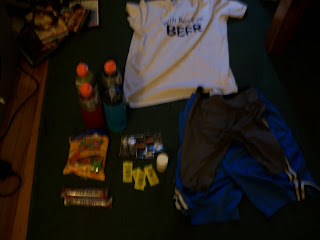Normally, the most important workout is the long run because it most closely simulates the marathon. The least important for most people (except the most experienced runners), is speed work because there is both an increased risk of injury and the conditioning element is of minimal utility for most marathoners. Ideally, you have all of these elements in your training plan. Unfortunately, life is seldom ideal.
Which brings me to my case. Due to an injury after my last marathon I have been unable to accumulate the amount of weekly mileage I would like. Last year in the buildup to my marathon I was able to run at a peak of about 44 miles a week. This year it looks like maybe I might be able to get up to 39. This doesn't even really due justice to all the early season training I missed this year. Additionally, it has been unseasonably hot and humid this year (or at least it seems this way), which has hindered my ability to run at faster paces. So I have put an increased emphasis on the long run.
Yesterday, I ran an extremely slow 30 miles over rolling terrain. The hope is that this will make up for lost miles and also make covering the 26.2 miles just a little easier. It is after all, easier to run three miles if you have the ability to run six. Last year I had had difficulty in my marathon precisely where my longest run ended at 22 miles. Now, the run itself was slow very slow. The first 20 or so miles went more or less at the planned pace. The next 10 however were grueling. My body was completely depleted of glycogen.
Glycogen is carbohydrate stored in the muscles and the liver and provides much of your energy while running. Most people have about 2000 calories of glycogen in their body. When you run out of glycogen (known as the "wall") your body is forced to rely exclusively of conversion of body fat into energy. At about 60% of maximum heart rate glycogen is being burned at a higher rate and lactate acid is being produced at a high enough rate that it will continue to accumulate faster than it can be used, eventually leading to fatigue. Depletion of glycogen in a marathon will often occur in most amateur runners at 20 miles or sooner. The top marathon runners have developed their aerobic system to the point where they don't rely as heavily on glycogen until after their heart rate reaches about 85% of maximum. This allows them to avoid hitting the wall at all. Lucky bastards.
The idea behind this workout is that I would deplete my glycogen stores and be forced to rely solely on fat oxidation for energy. The last five miles was pretty much a walk-shuffle-walk. It is also a kind of mental training to force yourself to keep going when your body has nothing left. There were several other factors that hopefully made this workout effective among them the rolling hills which, like speed work, increase efficiency and form.
The run went a long a five mile loop with about two miles of rolling hills at the start then mostly flat terrain for the remainder of the run. I used my car as an aid station where I could get Gatorade and mentally reset for the next five mile loop.
 |
| The Berlin Pond. Isn't it pretty? |
During the run I consumed four 24 ounce Gatorade Endurances', two packs of Shot Bloks, some gummy bears, and an unknown quantity of water. I still managed to lose 10 pounds of water weight during the course of the run.
 |
| Long run provisions. |
Doing a workout like this is one thing, recovering from it is a whole other animal. By my calculations I burned approximately 3,600 calories over the course of the run. Add that to the estimated 2,500 I need just to maintain my weight normally without any activity and that means I need to consume about 6,000 just to break even. This is difficult even when consuming junk food, but I did my best probably still leaving myself at a caloric deficit by the end of the day. Eating carbohydrates is important to replace the depleted glycogen and protein is important to try and repair muscle damage that has occurred over the course of the run.
The other thing I do to recover is take an ice bath shortly after the run. The idea behind this is that it allows blood to rush to the legs and not only gets more blood to tendons and ligaments to help them recover, but assists in flushing waste out of the muscles. I look at it primarily as a more effective method of icing.
This will be the longest run of my training cycle. I plan on building up weekly mileage for the next two weeks then taper it down in preparation for the marathon. Hopefully, it all works out.
I'll let you all know how it goes. Keep training.





No comments:
Post a Comment